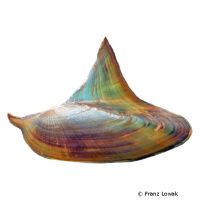Shark Fin Mussel (Hyriopsis bialata)
| Shark Fin Mussel Hyriopsis bialata | |
|---|---|
| Name | Shark Fin Mussel |
| Name Lat. | Hyriopsis bialata |
| Family | Unionids |
| Family lat. | Unionidae |
| Order | Unionids |
| Order lat. | Unionida |
| Origin | Southeast Asia |
| Habitat | Lakes, ponds |
| Diet | Plankton, detritus, fish food |
| pH | 6.5-8.5 |
| Behavior | Peaceful |
| Keeping | Individual, group |
| Care Level | Moderate |
| Reproduction | Larvae stages |
| Breeding | None reported |
| Life Span | N/A |
| Protection | No |
| Metric Units | |
| Size | 15 cm |
| Temperature | 20-28 °C |
| Hardness | 6-20 °dH |
| Aquarium | ~ 60 l |
| US Units | |
| Size | 6" |
| Temperature | 68-82 °F |
| Hardness | 107-356 ppm |
| Aquarium | ~ 15 gal |
Distribution and habitat
The range of the shark fin clam extends from Indonesia through Thailand and southern China to southern Japan. They are found in plant-rich stagnant waters, such as lakes, ponds and pools, but also in oxbows and bays of slow-flowing waters, where they usually live buried in the muddy bottoms.
Maintenance
The aquarium should have a robust border planting and offer sufficient free bottom areas. To be able to burrow in, they need a soft, fine-grained, 10-15 cm deep substrate, which can be covered with some foliage (e.g. sea almond leaves, oak leaves). Slightly dim light (floating plants), medium to hard water and a weak current is ideal.
No ammonia, ammonium and nitrite should be detectable in the aquarium water, and the nitrate value should not exceed 50 mg/l. To ensure the water quality and oxygen content, a filter and heater adapted to the aquarium size is required, as well as lighting for the species-appropriate day-night rhythm of the animals. When choosing the filter, special care should be taken to ensure that only a weak current is created and that not too many suspended particles are filtered out of the water, as these serve as food for them.
Diet
Sharkfin mussels are filter feeders that feed on phyto- and zooplankton, detritus and other suspended matter. It stirs up the bottom substrate somewhat with its foot and swirls in the water. The food is filtered out of the water through the gills and passed on to the mouth opening. Additionally, fine dust food, spirulina powder and commercial plankton food for filter feeders should be fed. Regular and varied feeding promotes health and increases resistance.
Behaviour and compatibility
They are completely peaceful and can be socialized with fish, snails, shrimp and crayfish without any problems. Caution is advised with large crayfish, which can open and eat pond mussels. Basically, only mutually compatible species with similar requirements for water quality and water temperature should be socialized.
Reproduction and breeding
Shark fin clams are hermaphrodites and capable of self-fertilization. The eggs are fertilized in the gills of the mussels and cared for for several months in the crevices between the gills (long brooders). As tiny bivalves, they eventually leave the parent and adopt the filter-feeding lifestyle.
There are no reports of successful breeding in the aquarium to date.
Important
In aquaculture, shark fin clams are important as food and for pearl extraction. It can move slowly with its foot by stretching it forward and then dragging its body. When feeding, their shells are only slightly open. Dead mussels can be recognized by their wide open shells
To build their shells they need a sufficient supply of lime. Especially in soft, acidic water, shell damage (holes) can occur due to a lack of lime, which can lead to death. Therefore, special attention should be paid to the calcium concentration in the water and, if necessary, calcium should be added in the form of limestone or special preparations from the specialized trade.
The well-being of the animals should be checked regularly. The temperature should be checked daily, the pH value, hardness and nitrate value at least every 14 days. A regular partial water change is recommended, even if the pollutant load has not yet reached the upper limit. Sudden changes in water quality should be avoided. Newly introduced animals must be accustomed slowly to the water in the aquarium.
Further literature can be found in your pet store.
References
Text: Barbara Pachner; Image: Franz Lowak
Source: BITTER (2008): Schnecken-Fibel, Dähne Verlag; ENGELMANN & LANGE (2011): Zootierhaltung - Tiere in menschlicher Obhut: Wirbellose, Verlag Harri Deutsch
